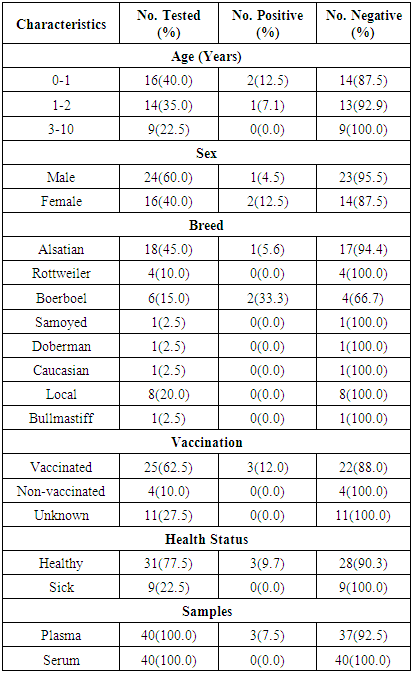-
Paper Information
- Next Paper
- Previous Paper
- Paper Submission
-
Journal Information
- About This Journal
- Editorial Board
- Current Issue
- Archive
- Author Guidelines
- Contact Us
Public Health Research
p-ISSN: 2167-7263 e-ISSN: 2167-7247
2015; 5(4): 109-119
doi:10.5923/j.phr.20150504.05
Seropositivity of Canine Distemper Virus (CDV) in Dogs Presenting at Abeokuta, Nigeria
Babalola Eunice Temilade 1, Olakunbi Ore-Ofe Solomon 1, Omoshaba Ezekiel Omotayo 1, Okonko Iheanyi Omezuruike 2
1Department of Veterinary Microbiology & Parasitology, Federal University Of Agriculture, Abeokuta, Nigeria
2Medical Microbiology Unit, Department of Microbiology, University of Port Harcourt, Port Harcourt, Nigeria
Correspondence to: Okonko Iheanyi Omezuruike , Medical Microbiology Unit, Department of Microbiology, University of Port Harcourt, Port Harcourt, Nigeria.
| Email: |  |
Copyright © 2015 Scientific & Academic Publishing. All Rights Reserved.
Background: Canine distemper (CD) is a highly contagious, multi-systemic, and potentially fatal viral disease that was once recognized as the leading cause of death in dogs. Aims: This study was carried out to detect canine distemper virus (CDV) in plasma and serum samples of vaccinated and unvaccinated dogs in Abeokuta, Nigeria. The usefulness of a commercially available rapid canine distemper virus antigen test kits was also evaluated to determine the seropositivity of CDV in dogs. Methods: Rapid canine distemper virus antigen test kits® were used to detect the presence of CDV in dogs presented at the Veterinary Teaching Hospital, FUNAAB, Abeokuta, Nigeria. Forty dogs were enrolled in this study. Blood samples were collected from 40 dogs and screened for CDV and evaluation of post-vaccination immunity to CDV. Results: The age range of all the dogs sampled were from 3 months to 10 years. Of the 40 dogs tested, 3(7.5%) were positive for CDV and 37(92.5%) were negative. CDV was only detected in plasma samples and none in serum samples. Among 25(62.5%) dogs with known history of vaccination, 3(12.0%) were positive for CDV. None (0.0%) of the 4(10.0%) unvaccinated dogs and 11(27.5%) with unknown history of vaccination had CDV. Higher prevalence was observed in females (12.5%) than males (4.5%). CDV was only present in Boerboel (33.3%) and Alsatian breeds (5.6%). CDV was also present in apparently healthy dogs (9.7%). Conclusions: This study has further confirms the presence of CDV in 7.5% of the dogs in Abeokuta, Nigeria. The study showed significant association (p< 0.05) with age, sex, breeds, vaccination, health status, sample types and CDV seropositivity. This study further confirms the efficacy of rapid canine distemper virus antigen test kits in the detection of CDV in plasma of dogs.
Keywords: CDV, Dogs, Antigens, Seropositivity, Vaccination
Cite this paper: Babalola Eunice Temilade, Olakunbi Ore-Ofe Solomon, Omoshaba Ezekiel Omotayo, Okonko Iheanyi Omezuruike, Seropositivity of Canine Distemper Virus (CDV) in Dogs Presenting at Abeokuta, Nigeria, Public Health Research, Vol. 5 No. 4, 2015, pp. 109-119. doi: 10.5923/j.phr.20150504.05.
1. Introduction
- Canine distemper, a potentially fatal viral disease, multi-systemic and highly contagious disease caused by canine distemper virus (CDV), was recognized as one of the leading cause of death in dogs [1]. CDV is related antigenically to dolphin distemper virus (DDV), human measles virus (HMV), pestedepetits ruminant virus (PPRV) and rinderpest virus (RPV) [1, 2]. CDV was also recognized as a wide host range enzootic disease which has been reported in most parts of the world, Nigeria inclusive [1, 3]. In recent years, it has acknowledged pronounced consideration all over the world [4]. CDV primarily affects dogs and several other animals’ species [1, 5-7]. It affects animals in the families of Canidae, Mustelidae, Mephitidae, Hyaenidae, Ailuridae, Procyonidae, Pinnipedia, and some Viverridae and Felidae [8-9]. CDV is generally transmitted in dogs via breathing of infectious sprays [4]. CDV in dogs leads to severe generalized or prolonged confined and tenacious infection in the central nervous system (CNS) [4, 10]. Infection caused by CDV might led to catarrhal form, subclinical disease, which involves in respiratory, gastrointestinal signs and systemic form considered as respiratory problems, rhinitis and fever, often linked to involvement of the CNS [1, 11, 12]. In addition, it causes a extremely transmissible systemic viral infection and frequently deadly disease followed by a multipivotal demyelinating CNS disease in several carnivorous species [1, 13-14]. CDV is mostly shed in oronasal discharges nonetheless entirely all secretions and discharges could still harbour the virus [1, 15, 16]. With the discovery and extensive management of vaccines against CDV, eruptions of disease are not common amongst pet dogs in developed countries [17]. Despite extensive vaccination in many regions, CDV remains a major disease of dogs and continued to stance a crucial danger for vaccinated and unvaccinated dogs, mostly dogs in exotic shelters [8-9, 17-19]. Unvaccinated populations offers unlimited risk to strayed and sheltered dogs equally. Eruptions of canine distemper lingers all over the world due to factors which comprise the irresponsibility of pet owners and the overpopulation of dogs. Dogs arriving animal housings differ in their health-status and characteristically have unknown histories of vaccinations [17, 19]. In Nigeria, CDV vaccines are commercially available, sold and given in combination with other vaccines such as leptospirosis, hepatitis, parainfluenza and parvovirus vaccines (DHLP+P combined vaccine) [20]. However, the use of available highly potent vaccines as well as maintaining high vaccine coverage in dogs’ populations and other susceptible species, still remains vital for the effective control of Canine distemper [21-22]. Different studies have documented cases of canine distemper in different susceptible species all over the world even in this vaccination era [23-31]. In recent years, the incidence of distemper in dogs appears to have increased despite the significant strides made in reducing the frequency of this disease through the use of modified-live CDV vaccines and the development of several diagnostic tests for specific viral diagnosis [1]. Concrete diagnosis of canine distemper is principally centred on clinical notion [32]. Several virologic and serologic techniques exist for the diagnosis of the disease [4, 32-33]. Currently, serum antibodies were identified by different methods comprising neutralization assays, ELISA [4, 34] and Imunoflorescence antibody [4, 32, 35, 36] which are diagnostic techniques of choice [4]. Serum neutralization has been used to identify antibodies in dogs and many species of carnivores [4, 15, 37-39]. Infectious CDV-antibody complexes are present in sera from dogs during severe stage of infection [40]. Recently, a substantial amount of CDV outbreaks have been reported in animal shelters in North America [17, 41-48]. Notwithstanding the transmissible nature of CDV, the occurrence of antibodies to CDV amongst dogs appears low in England [32, 49], Turkey [4, 50], Nigeria [32, 51], Japan [32, 52], Sweden [32, 53], United States [32, 54] and other species in Canada [32, 55] and Alaska [32, 56]. This difference might be owing to the warm weather of the region and due to the point that CDV is unsteady and depreciates faster outside the host [8, 32, 57].Although, previous authors indicated the seroprevalence of CDV infection in large felids [58-59], in a tame Bengal tiger [58, 60], in the African felids in different zoos in the United States [58, 61], in the lion population of the Tanzanian Serengeti National Park [58, 62-63], the prevalence of CDV in Nigeria remains obscure, and there are limited reports about naturally occurring morbillivirus infections in domestic dogs [58]. Most of these studies has shown that measuring of antibody titers in order to assess the immune status of dogs and cats before revaccination is a possibility [64-66]. Other studies have advocated that dogs should be tested regularly for antibody titers, and only dogs showing negative, borderline, or low antibody titers should be revaccinated instead of the annual vaccination which is commonly practiced [64-70]. Previous results sustained existing recommendations that irrespective of physical condition or source, vaccination of all dogs once on admittance to shelters [17]. Thus, a reliable, affordable, and standardized assay is advocated [64-65, 68]. CDV antibody titers can be used to evaluate whether distinct dogs are secured against infection [17-19, 71-73]. The bulk of puppies obtain antibodies to CDV through placenta or colostrum [4]. Because of the global distribution of CDV and the existence of extensive diversity of its predisposed host [74], it might be difficult to eliminate the virus [4], however, the infection can only be controlled realistically via vaccination [4, 75]. Currently, a growing amount of CDV occurrences of changing brutality amongst rural and urban dogs had ensued. However, precise laboratory analytical assessments are unavailable to reaffirm the notion of CDV infections and clinical veterinarians essentially depend on nonspecific outcomes of routine laboratory techniques or pathologic definitions. In this study, rapid CDV antigen test ELISA kits was employed to test for the existence of CDV antibodies in vaccinated and unvaccinated dogs in Abeokuta, Nigeria. Therefore, this present study was carried out to determine the seropositivity of CDV in plasma and serum samples of vaccinated and unvaccinated dogs in Abeokuta, Nigeria, in order to dissipate worries that stray dogs are the leading source of CDV in an urban environment as has been earlier reported [4, 76]. It also seeks to provide baseline information on the usefulness of a commercially available rapid canine distemper virus antigen test kits in determining the seropositivity of CDV in dogs.
2. Methods
- Study populationForty dogs of different sexes, ages, breeds, vaccination and health status were enrolled in this study (Table 1). These dogs were presented at random for treatment, routine check-up and vaccination at the Veterinary Teaching Hospital, Federal University of Agriculture, Abeokuta (FUNAAB). The dogs used in this study were owned and maintained fully under domestic setting by clients. Selection for study was done based on accessibility, availability and thorough examination of the dogs and their medical records. Dogs were divided into four groups of 10 taking into account history and time since last vaccination from the date of blood sample collection. The correlation between age, sex, breeds, vaccination, health status and seropositivity of CDV were evaluated. Ethical ConsiderationsThe ethical approval was granted by the Ethical Review Committee of the Veterinary Teaching Hospital, Federal University of Agriculture, Abeokuta (FUNAAB). Informed consent was obtained from the dogs owners and relevant confidentiality was maintained throughout the study. Sample collection and plasma preparationBlood (5mls) was collected from the cephalic or recurrent tarsal vein on dogs presented at the Veterinary Teaching Hospital, FUNAAB using sterile needle and syringe. The sites of injection were prepared aseptically with swabs soaked in methylated spirit. Blood samples collected were aseptically transferred into a sterile plastic universal bottle containing no anticoagulants. The samples were kept under room temperature of 20-25°C on a slanting position and they were left for 4-5 hours for proper clotting. Each blood sample were centrifuging at 4,000 revolutions per minute using the bucket centrifuge in order to separate the serum from the red cells. Serum was decanted using sterile pipette into labeled eppendoff tubes and stored at -20°C for serology.Data collectionRecords and data of dogs from which samples were collected were appropriately documented in the “Pet Evaluation Form”. Sera were tested immediately using rapid canine distemper virus antigen test kits (Bionote Vet. Diagnostic).Serological Analysis A 40-sample in-clinic dot-rapid CDV antigen test kits (Bionote Vet. Diagnostic) which is commercially available was used for the evaluation of IgG antibody titers to CPV in sera and plasma of dogs. The test was carried out according to the manufacturer’s specifications. Data Analysis Relationships between age, sex, breed, level of immunity and time since last vaccination were determined using the Chi squared test at p < 0.05 significance level.
3. Results
- Dogs’ characteristicsA total of forty dogs were used for the study (Table 1). Twenty-four (60.0%) of the dogs were males while 16(40.0%) were females. Their age ranged from 3 months to 10 old. Sixteen (40.0%) were within age-group 0 to 1 year and 14(35.0%) were in age groups 1 to 2 and 9(22.5) were in age groups 3-10 years old. Thirty-two (80.0%) were exotic breeds while 8(20.0%) were indigenous breeds. Twenty-five (62.5%) were vaccinated, 4(10.0%) were non-vaccinated and 11(27.5%) dogs had unknown vaccination history. Thirty-one (77.5%) were apparently healthy while 9 (22.5%) were sick (Table 1). Serology outcomeOf the 40 dogs tested, 3(7.5%) were positive for CDV and 37(92.5%) were negative. The study showed significant differences (p < 0.05) in age, sex, breeds, vaccination status and CDV seropositivity (Table 1). In this study CDV was only detected in plasma samples and none in serum samples. Three (12.0%) of the dogs known history of vaccination were positive for CDV. None (0.0%) of the unvaccinated dogs and those with unknown history vaccination (0.0%) tested positive to CDV (Table 1).
|
 | Figure 1. Relationship between age and CDV seropositivity |
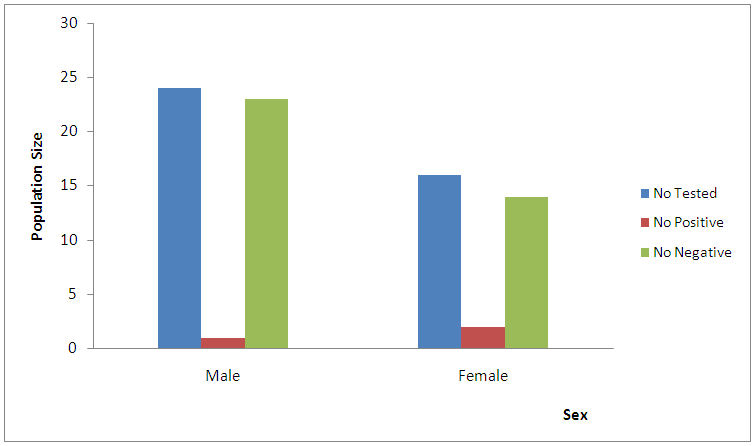 | Figure 2. Relationship between sex and CDV seropositivity |
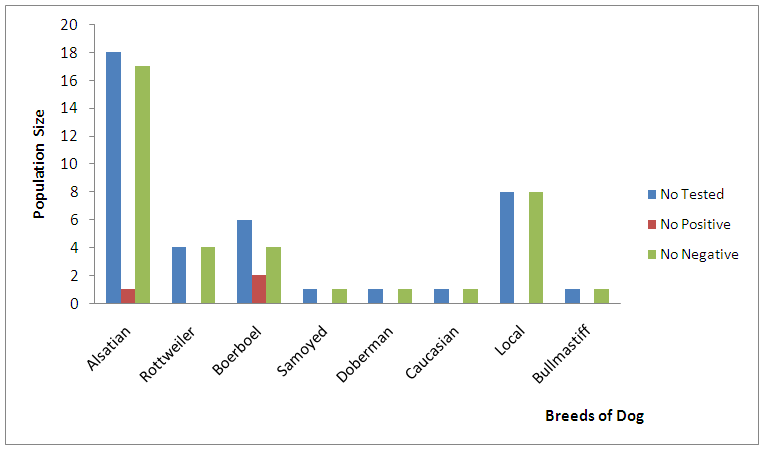 | Figure 3. Relationship between breeds and CDV seropositivity |
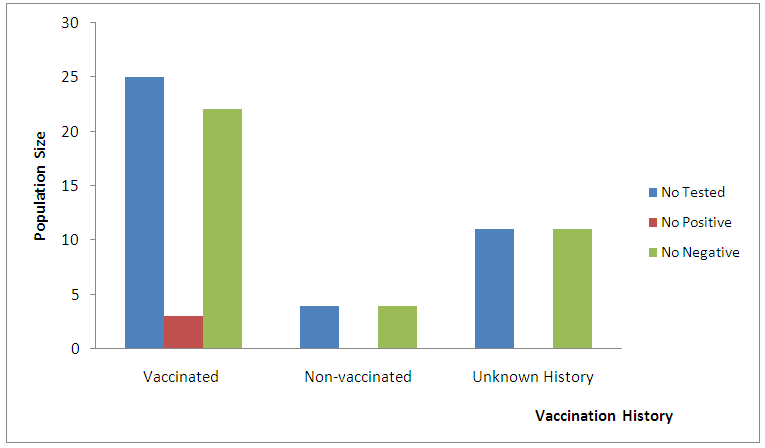 | Figure 4. Relationship between vaccination and CDV seropositivity |
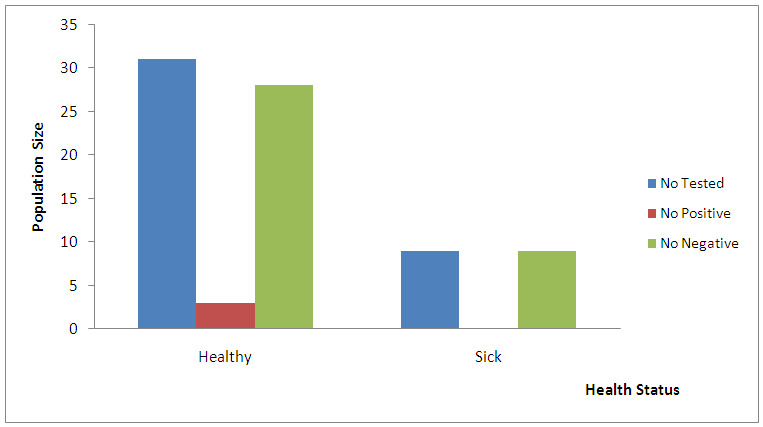 | Figure 5. Relationship between health status and CDV seropositivity |
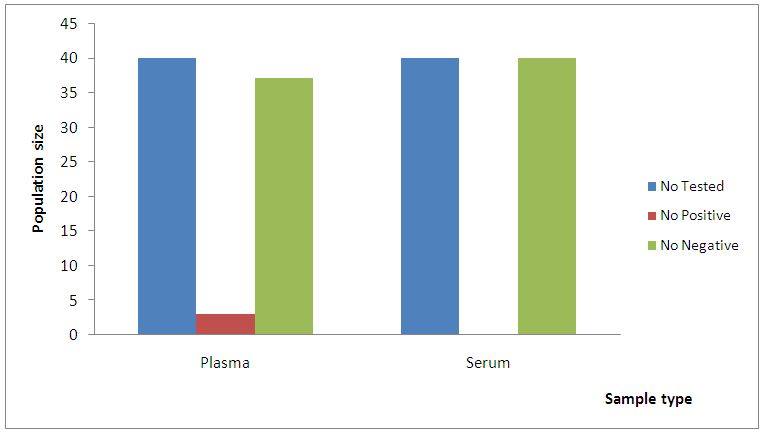 | Figure 6. Relationship between sample type and CDV seropositivity |
4. Discussion
- This present study was carried out to determine the seropositivity of canine distemper virus (CDV) in plasma and serum samples of vaccinated and unvaccinated dogs in Abeokuta, Nigeria and seeks to provide baseline information on the usefulness of a commercially available rapid canine distemper virus antigen test kits in determining the seropositivity of CDV in dogs. In principle, presence of the viral antigen indicates animal exposure to the virus and this was determined using a commercially available 40 samples canine distemper virus test kits. From the result obtained, 7.5% were positive for CDV and 92.5% were negative. In this study CDV antigen was only detected in plasma samples and none in serum samples. Among 25 dogs which had known history of vaccination, 12.0% tested positive for CDV. Overall, seropositivity to CDV in this study was not comparable to those reported in previous studies [77-79]. It showed that some of these dogs harbor CDV antigen despite vaccination. This could be attributed to vaccination failure [1]. Previously, studies have shown that one of the causes of vaccine failure could include result of maternally derived antibody (MDA) or passively acquired antibodies (PAA) at the time of vaccination [1, 64, 80]. However, delay in the maturation of immune system or organs, genetic inability to respond to certain vaccine antigens, ineffective vaccine lots, immunosuppression as well as poor vaccinal immunogenicity have been shown to be the causes of vaccine failure [1, 64, 80]. It has also been reported that one factor which has been regarded as a major cause of CDV vaccination failures in young dogs is interference by MDA or PAA [1, 81-83]. Waner et al. [84] in their study reported that insufficient vaccinations, multiple vaccinations and/or vaccination failures due to faulty vaccine and interference by MDA are the major cause of CDV persistence.From the 25 dogs with known history of vaccination, 22(88.0%) tested negative for CDV antigen. It showed that some of these dogs did not harbor CDV antigen. Previous studies have shown that vaccinations of dogs with available vaccines conferred and maintained adequate immunity for 3 or more years [54, 64, 81, 85-87]. Owing to the fact that 88.0% of the vaccinated dogs tested negative for CDV antigen, this study also gave credence to previous studies which reported that the prevalence of Canine Distemper in the community has decreased dramatically due to increase vaccination of pets by owners [64]. Vaccination still remains the most cost-effective ways of controlling canine distemper. The general use of modified live vaccines (MLV) has been shown to have greatly reduced the incidence of canine distemper in dogs [22]. The rapid kit used in this study was able to show that 3(7.5%) dogs presented to the clinics still harbour CDV while 37(92.5%) of the dogs tested negative for CDV antigen. This deviate from what was reported by Waner et al. [64] and Eghafona et al. [1]From the four unvaccinated dogs (10.0%), none (0.0%) tested positive to CDV antigen. This is consistent with previous studies. Avizeh et al. [32] reported that 17.52% of animals had antibodies to CDV in Iran which point to a prior contact to wild-type CDV, since the animals were unvaccinated. It has been reported that ELISA is a more sensitive assay in that it measures all CDV-specific antigens or antibodies [79, 84]. Findings reported by Eghafona et al. [1] has also shown that, some unvaccinated dogs exhibited some level of antibody against CDV. Such detectable antibodies must have been due to the natural exposure of such dogs to CDV [1]. However, this study has proved otherwise in that none of the unvaccinated dogs had CDV antigen. From the 11 dogs (27.5%) with unknown history of vaccination, none (0.0%) tested positive to CDV antigen. This could point to the fact that these dogs may not have been previously vaccinated or exposed to CDV [79]. This could also be attributed to the fact that the dogs have not strayed. Another possible reason could be that these dogs were kept by ignorant owners or those who are unwilling to present their pets for immunizations and personal experience [1, 88]. The potential risk of this is the pool of unvaccinated dogs in shelters which are a susceptible reservoir to CDV infection and potentially a threat to other dogs and to wildlife [79].In this study, the ages of the dogs were between 3 months and 10 years old. The study showed significant differences (p < 0.05) between age and seropositivity of CDV. However, higher prevalence was observed in ages 0-1 years of age (12.5%) compared to their counterparts in age group 1-2 years (7.1%) and 3-10 years (0.0%) with zero prevalence. This is in disagreement with the report of Gorham [89] and Böhm et al. [90]. It also disagrees with Avizeh et al. [32] who claimed in their study that age was insignificantly related to CDV antibody titers however greater in adult dogs than puppies. Age-related seroprevalence of CDV in dogs was insignificant in former serologic studies [4, 54, 68]. Nevertheless, other earlier studies indicated that seropositivity of CDV were most predominant in adult dogs than in juveniles [4, 91-92].Some studies reported that gender has no significant role in the susceptibility of animals to canine distemper (CD) [8]. In this study, 60.0% of the dogs used were males and 40.0% were females. The study also showed significant differences (p < 0.05) between sex and seropositivity of CDV antigen. Higher prevalence was observed in females (12.5%) compared to their male counterparts (4.5%). This disagrees with the previous study by Twark and Dodds [68], McCaw et al. [54], Cattet et al. [55], Zarnke et al. [92] and Eghafona et al. [1] who reported no association with sex.Also in this study, thirty-two (80.0%) of the dogs used were exotic breeds and 8(20.0%) were indigenous breeds. The study also showed significant differences (p < 0.05) between breeds and seropositivity of CDV. Higher prevalence was observed in Boerboel dogs (33.3%) compared to other breeds. Alsatian breed had a seropositivity of 5.6%. Zero seropositivity were recorded among Rottweilers, Samoyed, Doberman, Caucasian, Bullmastiff and local breeds. This agrees with the report of Waner et al. [88] and Eghafona et al. [1]. Eghafona et al. [1] reported that breeds showed significant association with CDV. However, our finding disagrees with the previous study by Twark and Dodds [68]. Although, antibodies due natural exposure to CDV is common in strayed mongrel breed of dogs [1, 88], this study found no CDV antigen in local (mongrels) breeds despite that their vaccination history was unknown. Thirty-one (77.5%) of the dogs used in this study were apparently healthy and 9 (22.5%) were sick. The study also showed significant differences (p < 0.05) between health status and seropositivity of CDV. Though, higher prevalence was observed in healthy dogs (9.7%) than sick dogs (0.0%). According to Rockborn [93] and Greene and Appel [94], over half of the CDV infections in domestic dogs are subclinical. CDV infection rate has been estimated to be significantly higher than the disease rate [93-94]. However, Eghafona et al. [1], attributed this to persistence of immune memory cells and cell-mediated and mucosal immunity. Despite vaccination, CD continues to occur among vaccinated individuals and populations [95, 96]. It has been widely reported that CDV is susceptible to the environment and tends to induced relatively low immunity [1, 64, 87, 97]. Twenty-five (62.5%) of the dogs used in this study were vaccinated, 4(10.0%) were non-vaccinated and 11(27.5%) dogs had unknown vaccination history. Yet, the study showed significant differences (p < 0.05) between vaccination and seropositivity of CDV. Though, prevalence was higher in vaccinated dogs (12.0%) than unvaccinated dogs (0.0%) and those with unknown vaccination history (0.0%). This is in consonance with the findings of some previous studies [1, 64, 87, 97]. Previous studies have shown interfering levels of MDA/PAA that were transmitted by dogs to their offspring (through colostrum, and milk at a lesser extent) as the primary causes of failure of CDV vaccination [98]. Thus, Decaro and Buonavoglia [98] recommended that pups should be vaccinated only after waning of MDA in order to avoid interference with active immunisation [98]. Other proposed strategies to overcome the interference with MDA include high-titer vaccines [98, 99] and intranasal vaccination [98, 100].A total of 40 plasma and 40 sera samples were collected and evaluated in this study. Only plasma samples (7.5%) of the tested dogs were seropositive to CDV. The study showed significant differences (p < 0.05) between samples types and seropositivity of CDV. This agrees favourbly with the reports of Decaro and Buonavoglia [98] and Decaro et al. [101-102]. According to these authors, it has been proved that plasma samples from EDTA bottle were more useful in the diagnosis in the late stages of infection as viremia seems to be exceptionally long lasting [101-102].The low seropositivity (7.5%) of CDV reported in this study could be attributed to vaccination failure as indicated above and revaccination of these dogs is thus required. In this case, the use of rapid CDV antigen test kit will be significant in determining when the dogs should be vaccinated or revaccinated [1]. This study in agreement with previous studies has shown the diagnostic value of using the rapid canine distemper virus antigen test kits (Bionote Vet. Diagnostic) in CDV detections. One of the limitation of this study is the small number of dogs used. However, the result presented in this study is comparable to previous findings and has shown that in certain canine groups, such as shelter dogs, some may not be immune to CDV. According to Perrone et al. [79], such dogs may pose a potential risk/reservoir for zoonotic transmission.
5. Conclusions
- This study has further confirms the presence of CDV in 7.5% of the dogs in Abeokuta, Nigeria. The study showed significant association (p< 0.05) with age, sex, breeds, vaccination, health status, sample types and CDV seropositivity. It also showed that 12.0% of the vaccinated dogs in Abeokuta, Nigeria still harbours CDV. This study further confirms the efficacy of rapid canine distemper virus antigen test kits in the detection of CDV in plasma of dogs. The data presented in this study have demonstrated the diagnostic value of a rapid canine distemper virus antigen test kits for determining presence of CDV in plasma of dogs. It further confirms that CDV-antigen were detected in plasma only, thereby proving the diagnostic value of using the rapid canine distemper virus antigen test kits for the prompt detection of CDV. In conclusion, the presence of CDV in these vaccinated dogs may possibly become a cause of canine distemper infections dogs in Abeokuta. A likelihood of continued CDV secretion from the seropositives vaccinated dogs is likewise considered as a precarious fact for epidemiology of canine distemper in dogs. Consequently, on the status of the prominence of dogs as sentinels and marshals, vaccination of all dogs with potent vaccines in Abeokuta, Nigeria is highly suggested.
ACKNOWLEDGEMENTS
- The authors wishes to appreciate the management and staff of Veterinary Teaching Hospital, Federal University of Agriculture, (FUNAAB), Abeokuta, Nigeria for their approval and assistance during this study. The exceptional support of all the consented clients who volunteered their dogs for this study is sincerely appreciated.
 Abstract
Abstract Reference
Reference Full-Text PDF
Full-Text PDF Full-text HTML
Full-text HTML